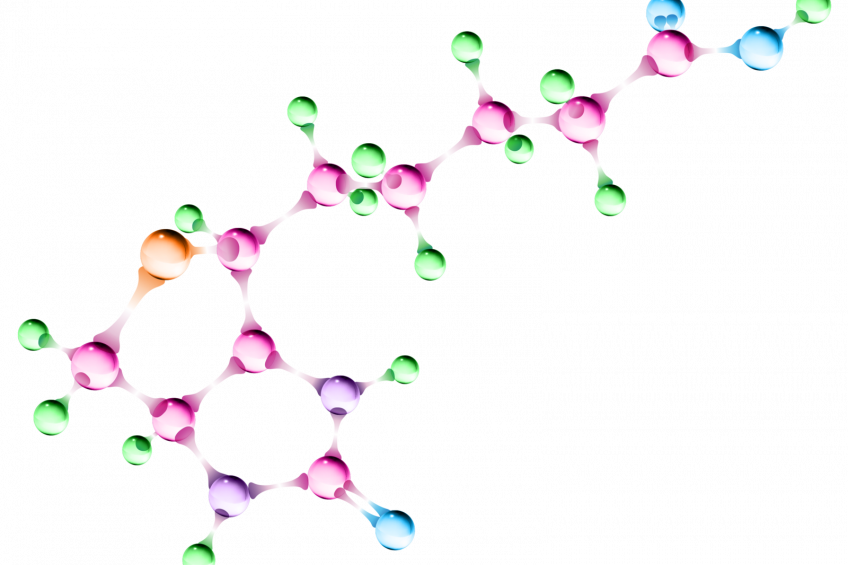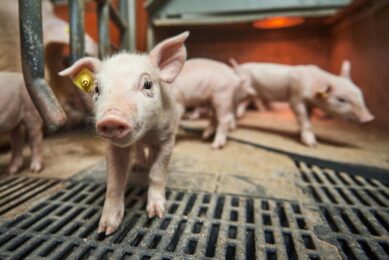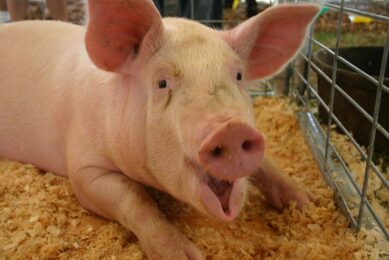A helping hand to find optimal vitamin levels

In previous editions, attention was paid to the question what vitamins can do for livestock – and most importantly for pigs, vitamin E. Key in this last episode is to find the best way of establishing optimal vitamin supplementation requirements for all classes of pigs.
By Dr Gilberto Litta and Antoine Meuter, DSM*
Vitamin nutrition requires very careful review at all stages in formulation and use. As genetics change rapidly, the requirements for vitamins also change. This equates to an increased requirement in pigs of about 1% per annum and over five years this can account for significantly different concentrations in feeds to maintain performance.
In Figure 1 the 15 year time trends are shown, for both litter size and litter weight in F1 breeding females in PIC multiplication stock. Over this time, litter size increased by +2.4 piglets and litter weight increased by +6.4 kg. Similar trends have been recorded in growth and carcass traits.
Clearly it is imperative to review vitamin requirements at regular intervals to ensure optimisation. Achieving optimum positions on vitamin inputs is, in practice, increasingly complex and as feed costs increase then the optimum operating level of pig performance might not concur with the maximum levels of nutrient inputs. It is essential to optimise vitamins as part of this review process.
In the United States, the new NRC (National Research Council) Nutrient Requirements of Swine has been published recently and reviews new research to give recommendations including vitamin inputs. NRC provides a minimum level of vitamin inputs to ensure the absence of deficiency effects but the data cannot provide for optimisation with modern genetics.
DSM Nutritional Products have tackled this problem head on by developing a more comprehensive analysis based on wider commercial data and experimental work. This is the basis for the Optimum Vitamin Nutrition (OVN) concept. This provides for a range of animal production situations (operating levels) and gives a guide towards final inclusion levels for all of the vitamins. Figure 2 illustrates schematically the basis of this concept.
The concept provides a cost-effective range of vitamin supplementation therefore optimising the animal performance and health and can accommodate different levels of health status and genetic differences. During the last ten years within the poultry industry (which often is ahead of the pig industry in terms of technical applications) vitamin levels recommended by independent researchers and advisers has progressively embraced this concept and has been extensively adopted in practice.
Cost savings
The pig industry is now following suit and as formulators look for savings in grist costs then optimisation makes good commercial sense. It is known that vitamin inputs in compound feeds represent 60% of the total number of feed ingredients but only 2% of the feed cost itself and yet influence 100% of metabolic processes for growth, health and reproduction. It is therefore necessary to use correct levels right to secure optimum financial performance.
The performance and animal responses, where vitamin levels are well below optimised values, was illustrated back in the mid-1990s when some of the largest pig producers in North America tried to cut costs during the feed cost crisis at that time by withdrawal of premix components in finishing pigs from 90 kg through to slaughter at 118 kg. The upshot is illustrated in Figure 3. There was a disastrous effect on the final daily gain to slaughter. There was a loss of 40 g/d daily gain through this phase and not only did the pigs take longer to reach slaughter weight – which disrupted the batch management in the large herds but it also raised overall feed costs.
Table 1 shows the mean recommended vitamin inputs for the various categories of pigs including breeding females and boars. These data are based on detailed on-farm trials (commercial and university) with NRC recommendations as a base. NRC, in fact, can be considered as a minimum position. The mean NRC figures were based originally on studies using purified mash feeds under experimental conditions (no stress, ideal environments with no pathogenic challenge). In the ‘real commercial world’ all of these points have to be accommodated when arriving at the correct optimised vitamin levels. This is exactly how the OVN guidelines have been constructed.
Other considerations
There are also other considerations in arriving at specific requirements and these can be listed as:
- Immune response capacity: What level of challenge will be present? What level of immunity is required?
- Breeder longevity: How long will breeding females stay in the herd on average.
- Viability of neonatal piglets: What is the mortality percentage?
- Adaptation to stress: Mostly buildings and environments.
- Responses to vaccination programmes
All of these factors tend to increase the demand for vitamins. Vitamins can almost never be considered as specific nutrients in isolation given that they display a wide range of interactions.
B vitamins, for example, are regulators of the intermediary metabolism of proteins, fats and carbohydrates and a lack of any one of them increases the need for others. Fat soluble vitamins must also be optimised by feeding them in the correct ratios because they all compete for intestinal absorption. It is problematic therefore to estimate precisely the optimum vitamin requirement for each vitamin separately and simple mathematical relationships cannot be established.
It is also the case that what we can call nutraceutical levels have been established for some vitamins (e.g. vitamin E) where known dose response relations have been observed in many studies. Vitamin E and immune responses is of course the classic example. The other problem with evaluating optimum vitamin levels is that the availability of natural vitamins from feed materials is not precisely known and variability is high. Storage and processing methods will also influence levels greatly. Supplementation must also include safety margins to take account of feed processing losses, inaccurate mixing, mycotoxin damage and pathogen challenge.
Supplementation levels for all vitamins therefore needs to be constantly updated because of these factors. Some vitamins can also be strategically increased – such as vitamin E, vitamin C and Biotin because of their known nutraceutical properties. The OVN levels provide the actual vitamin level to be added regardless of the natural content of feedstuffs. It is also the case that increasing vitamin levels to optimise effects is not harmful or detrimental to pigs. For group B vitamins it is even not appropriate to talk about toxicity levels as the amount in excess is simply excreted. In the case of vitamin A and D3 a toxicity level can be defined but at levels higher than ten times the maximum OVN levels.
Vitamin E
Although the minimum NRC (1998) vitamin E level is 16 IU/kg for piglets less than 10 kg and 11 IU/kg for grower/finisher pigs there has been much experimental data to show that beneficial biological responses can be achieved at much higher levels. As a powerful antioxidant, vitamin E supports improved immunity in terms of antibody/immunoglobulin production and responses to antigenic challenge. Most of these responses show linear trends to extra supplementation. There is also a sharp decline of vitamin E in piglet plasma at weaning and this exposes the piglet to oxidative processes that are damaging to immunity.
Immune responses were shown in fact to increase significantly when vitamin E levels were supplemented to 136 IU/kg. It has also been very well documented that using 200-250 IU/kg in finishing pigs yields good oxidative stability in the meat itself and meat colour is also improved via this route. The water holding capacity of meat is also enhanced by extra vitamin E supplementation.
Vitamin E OVN level supplementation in breeding sows and gilts also provides good responses via transfer to piglets in colostrum and milk. Piglet immunity can be augmented via this route. Positive responses have also been reported in boar feeding and at 150-200 IU/kg of vitamin E supplementation sperm viability is enhanced and in some studies sperm concentrations in semen were raised.
Clearly vitamin E is a key vitamin and central to high performance pig production. The levels need reviewing constantly as the farm situations change but OVN guidelines are the main starting point.
References available on request.
* Dr Gilberto Litta is global category manager vitamins for DSM and Antoine Meuter is regional category manager vitamins, Europe for DSM.
Join 18,000+ subscribers
Subscribe to our newsletter to stay updated about all the need-to-know content in the pigsector, three times a week. Beheer
Beheer










 WP Admin
WP Admin  Bewerk bericht
Bewerk bericht